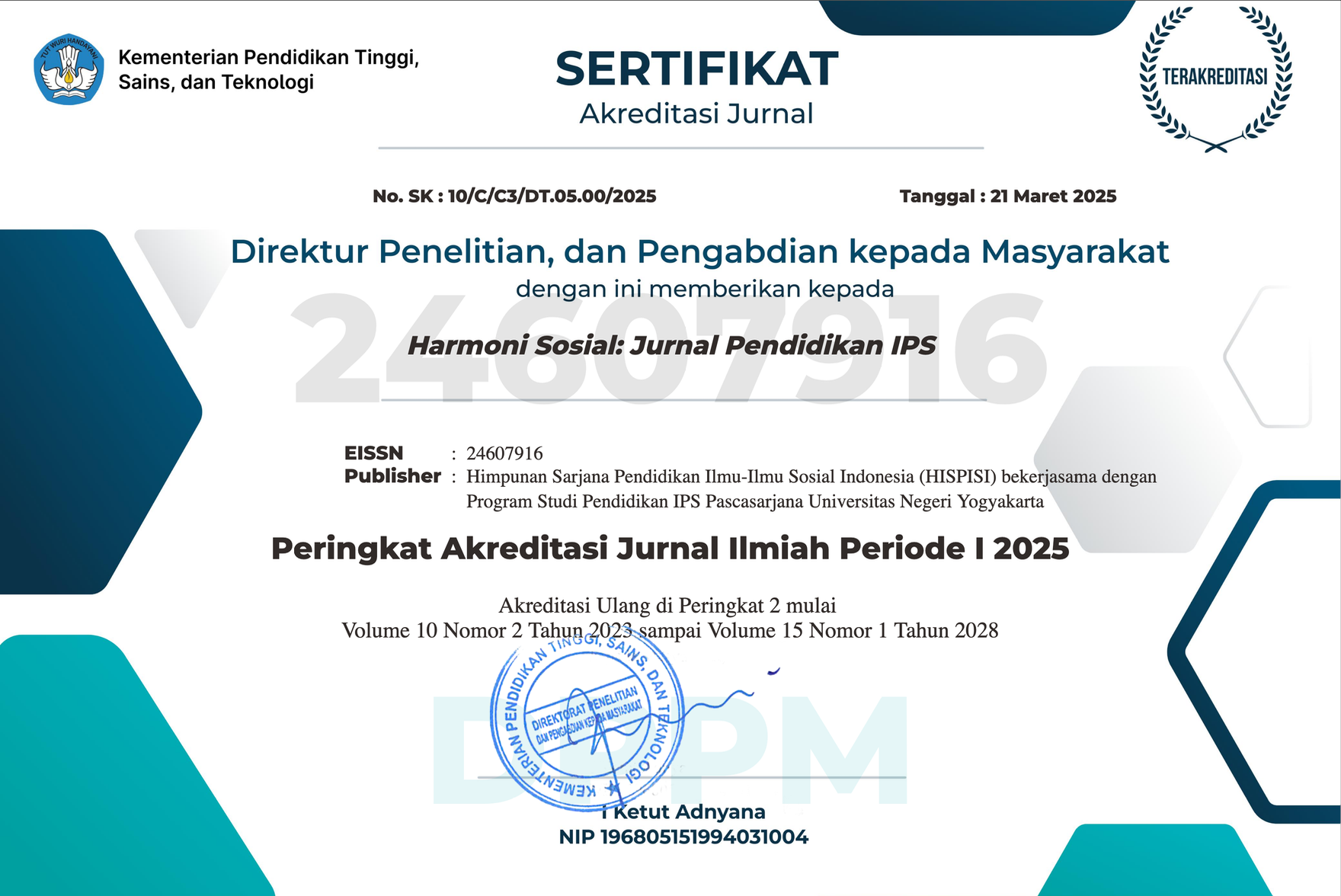The meaning of the Ceprotan tradition in bersih desa for the people of Sekar village
Downloads
Downloads
Arbay, E. A., & Laksmono, B. S. (2020). Tangible and intangible cultural heritage in support to post-war Biak tourism. Technium Social Sciences Journal, 14(1), 727-734. doi: https://doi.org/10.47577/tssj.v14i1.2040
Asri, D. P. B. (2016). Perlindungan dan pengelolaan budaya lokal di kota Yogyakarta. Jurnal Kajian Hukum, 1(1), 1-22. Retrieved from http://www.academia.edu/download/59879480/6-80-1-PB20190627-125447-1sp03nh.pdf
Bratawidjaja, T. W. (2000). Upacara Tradisional Masyarakat Jawa. Jakarta: Pustaka Sinar Harapan.
Cannigia, A. B. (2015). Potensi Upacara Adat Ceprotan Sebagai Wisata Minat Khusus Di Kabupaten Pacitan (Unpublished doctoral dissertation). Universitas Gadjah Mada, Indonesia.
Endraswara, S. (2006). Mistisisme dalam seni spiritual bersih desa di kalangan penghayat kepercayaan. Kejawen: Jurnal Kebudayaan Jawa, 1(2), 38-61.
Geertz, C. (1989). Abangan, Santri, Priyayi dalam Masyarakat Jawa. Jakarta: Pustaka Jaya.
Geertz, C. (1992a). Kebudayaan dan Agama. Yogyakarta: Kanisius.
Geertz, C. (1992b). Tafsir Kebudayaan. Yogyakarta: Kanisius.
Hussaini, M. (2020). The historical sources of nationalism in the contemporary China. Technium Social Science Journal, 13, 536-550. Retrieved from https://heinonline.org/HOL/LandingPage?handle=hein.journals/techssj13&div=48&id=&page=
Kastolani, K., & Yusof, A. (2016). Relasi Islam dan budaya lokal: Studi tentang tradisi Nyadran di Desa Sumogawe Kecamatan Getasan Kabupaten Semarang. Jurnal Kontemplasi, 4(1), 51-74. Retrieved from http://ejournal.iain-tulungagung.ac.id/index.php/kon/article/download/130/105
Kementerian Pendidikan dan Kebudayaan Republik Indonesia. (2018). Data pokok kebudayaan, profil objek tak benda. Retrieved from https://dapobud.kemendikmud.go.id
Khan, F. R., Iqbal, Z., & Gazzaz, O. B. (2012). Communication and culture: Reflections on the perspectives of influence. Wulfenia: Journal Klagenfurt, Austria, 19(8), 197-212. Retrieved from https://www.researchgate.net/profile/Fazal_Khan3/publication/253341225_Communication_and_culture_Reflections_on_the_perspectives_of_influence_Wulfenia_Journal_198_197-212/links/00b7d52678673420bd000000/Communication-and-culture-Reflections-on-the-perspectives-of-influence-Wulfenia-Journal-198-197-212.pdf
Lewisohn, L. (1997). The sacred music of Islam: SamÄ'in the Persian Sufi tradition. British Journal of Ethnomusicology, 6(1), 1-33. doi: https://doi.org/10.1080/09681229708567259
Luo, J., & Chen, F. (2016). Preservation of traditional culture in modern society: A case study of China Meishan Cultural Park. International Journal of Sustainable Development and Planning, 11(3), 416-425. Retrieved from https://www.witpress.com/cart/openaccessdownload
Meuleman, R., Bekhuis, H., Lubbers, M., & Scheepers, P. (2013). Own culture first? Nationalism and the preference for national cultural goods. International Journal of Public Opinion Research, 25(4), 436-458. doi: https://doi.org/10.1093/ijpor/eds024
Prayogi, R & Danial E. (2016). Pergeseran Nilai-Nilai Budaya Pada Suku Bonai Sebagai Civic Culture Di Kecamatan Bonai Darussalam Kabupaten Rokan Hulu Provinsi Riau. Jurnal Humanika, 23(1): 61-79.
Peursen, V. (1988). Strategi Kebudayaan. Yogyakarta: Kanisius.
Rudyansjah, T. (2015). Antropologi Agama. Jakarta: UI Press.
Prahastiwi, E. D. (2014). Nilai Pendidikan Dalam Budaya Ceprotan Masyarakat Desa Sekar Kecamatan Donorojo Kabupaten Pacitan (Doctoral dissertation, Universitas Muhammadiyah Surakarta).
Rathje, S. (2009). The Definition of Culture: An Application-Oriented Overhaul. Interculture Journal, 8(8): 35-58.
Rohani, R., Novianty, F., & Firmansyah, S. (2018). Analisis upaya melestarikan nilai-nilai budaya pada masyarakat adat Melayu di Kecamatan Sungai Kakap Kabupaten Kubu Raya. Vox Edukasi, 9(2), 271442. doi: https://doi.org/10.31932/ve.v9i2.174
Sertoglu, K., Ugural, S., & Bekun, F.V. (2017). The contribution of agricultural sector on economic growth of Nigeria. International Journal of Economics and Financial, 7(1), 547-552. Retrieved from https://www.econjournals.com/index.php/ijefi/article/view/3941/pdf
Setyawan, B. W., & Saddhono, K. (2018). Ceprotan performing art: A traditional folkart based on urband legend. Harmonia: Journal of Arts Research and Education, 18(1), 67-73. doi: https://doi.org/10.15294/harmonia.v18i1.9509
Sunjata, W. P. (2010). Upacara tradisional Ceprotan di Pacitan. Jurnal Patrawidya Seri Penerbitan Sejarah dan Budaya, 11(3), 771-789
Triwardani, R., & Rochayanti, C. (2014). Implementasi kebijakan desa budaya dalam upaya pelestarian budaya lokal. Reformasi: Jurnal Ilmiah Ilmu Sosial dan Ilmu Politik, 4(2), 102-110. Retrieved from https://45.32.120.76/index.php/reformasi/article/view/56
Tuan, T. H., & Navrud, S. (2008). Capturing the benefits of preserving cultural heritage. Journal Of Cultural Heritage, 9(3), 326-337. doi: https://doi.org/10.1016/j.culher.2008.05.001
Vecco, M. (2010). A definition of cultural heritage: From the tangible to the intangible. Journal of Cultural Heritage, 11(3), 321-324. doi: https://doi.org/10.1016/j.culher.2010.01.006
The Authors submitting a manuscript do so on the understanding that if accepted for publication, copyright publishing of the article shall be assigned to Harmoni Sosial: Jurnal Pendidikan IPS
 | Harmoni Sosial: Jurnal Pendidikan IPS by http://journal.uny.ac.id/index.php/hsjpi is licensed under a Creative Commons Attribution-ShareAlike 4.0 International License. |









 ISSN Print
ISSN Print









